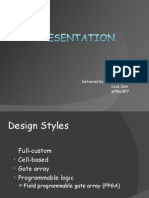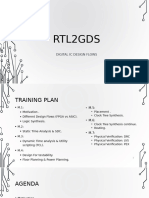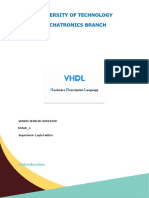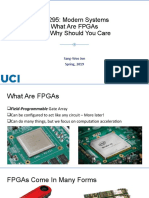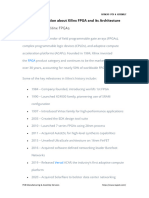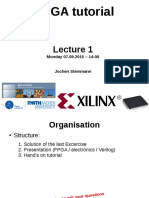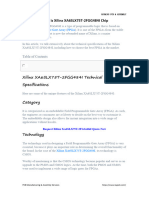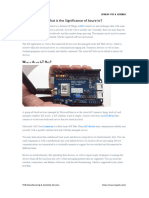An Introduction To How FPGA Programming Works
Uploaded by
jackAn Introduction To How FPGA Programming Works
Uploaded by
jackRAYMING PCB & ASSEMBLY
An Introduction to How FPGA programming Works
What is an FPGA?
A field programmable gate array (FPGA) is an integrated circuit that can be programmed and reconfigured
after manufacturing. This gives engineers the flexibility to customize the hardware logic and functionality of
the chip for a specific application.
FPGAs contain programmable logic blocks and programmable interconnects that can be wired together in
different configurations based on the designer’s requirements. By loading new programming, the logic cells
and routing connections can be changed to implement digital circuits ranging from simple logic gates to
complex arithmetic functions or custom hardware accelerators.
Some key capabilities of FPGAs:
Customizable digital logic using logic array blocks (LABs)
Flexible routing with programmable interconnects
Millions of gates available on a single FPGA chip
Reconfigurable even after deployment
Supported by design and programming software tools
This combination of adaptive hardware and software programmability makes FPGAs ideal for prototyping
digital systems and accelerating complex algorithms. Understanding how FPGA programming works
provides the foundation for effectively using this powerful technology.
Request PCB Manufacturing & Assembly Quote
FPGA Architecture Overview
PCB Manufacturing & Assembly Services https://www.raypcb.com/
RAYMING PCB & ASSEMBLY
Xilinx Zynq fpga
The core FPGA architecture consists of three main elements as illustrated below:
Configurable Logic Blocks (CLBs) – The basic logic cell used to construct digital circuits. CLBs contain
look-up tables (LUTs), flip-flops, multiplexers, and other standard logic.
Programmable Interconnect – Routing that connects the CLBs and other FPGA elements so they can
communicate. This includes wire segments and programmable switches.
I/O Blocks – The pins or pads that send signals on and off the FPGA chip. Enables interfacing with external
components.
By programming the functions in the CLBs and selectively enabling the desired programmable interconnect
paths between them, any digital circuit can be mapped onto the FPGA hardware.
Next let’s look at the FPGA programming process that defines this logic and routing configuration.
FPGA Programming Essentials
PCB Manufacturing & Assembly Services https://www.raypcb.com/
RAYMING PCB & ASSEMBLY
FPGA programming involves:
1. Designing the digital logic circuit you want to implement in configurable hardware
2. Synthesizing the design into standard cells
3. Mapping the cells to the FPGA’s CLBs, interconnect and I/Os
4. Generating the binary bitstream file used to program the FPGA
This flow from design entry through mapping ultimately produces the bitstream loaded into the FPGA to
activate the target digital circuit.
Let’s look at each step in more detail:
FPGA Design Entry
FPGA programming starts with defining your required functionality through:
HDL Coding – Using a hardware description language like VHDL or Verilog to describe the
digital logic design at the register transfer level (RTL). This defines the logical operation.
Schematic Capture – Graphically depicting the logic using library components with a schematic
editor. This captures connectivity.
High-Level Synthesis – Using a high-level language like C++ to specify algorithms that are
synthesized into hardware logic by the tool.
The output of design entry is a technology-independent representation of the desired circuit behavior.
Logic Synthesis
The next programming phase is logic synthesis which processes the design and maps it to physical gates and
flip-flops.
Key steps in synthesis:
RTL Analysis – Validate the design hierarchy and connectivity
Technology Mapping – Map abstract design elements into target standard cells
Gate Optimization – Minimize logic for most efficient gate implementations
Synthesis ultimately generates a gate-level netlist consisting of logic cell instances and connectivity ready
for FPGA mapping.
FPGA Mapping
The mapping stage takes the synthesized netlist and maps it onto the FPGA architecture:
PCB Manufacturing & Assembly Services https://www.raypcb.com/
RAYMING PCB & ASSEMBLY
Partitioning – Group logic into blocks that can fit within the CLBs
Placement – Determine exact CLB locations for each logic cell
Routing – Connect logic blocks based on available programmable interconnect
Mapping fits the design onto the FPGA fabric optimizing for performance, routing congestion,
and power consumption.
Bitstream Generation
Finally, bitstream generation converts the finished mapping into a binary file used to program the FPGA.
This configures the CLB functions and interconnect settings to activate that design on the FPGA hardware.
Key bitstream elements:
CLB Configuration – Sets the LUT logic functions in each used CLB
Interconnect Settings – Configures the programmable routing muxes
I/O Blocks – Defines the I/O standards and drive strengths
Clock Settings – Sets clock sources, PLL multipliers and divides
With this overview of the core programming flow, let’s look at each step in more detail.
FPGA Design Entry
PCB Manufacturing & Assembly Services https://www.raypcb.com/
RAYMING PCB & ASSEMBLY
Design entry is the creative phase where the desired circuit behavior and operation is defined using either
HDL code, schematics, or high-level source code. This establishes the functional specification that will be
implemented physically in the FPGA.
VHDL and Verilog Coding
HDL coding with languages like VHDL or Verilog provides complete control over the digital logic but
requires learning an FPGA-focused programming language.
Key HDL coding steps:
Define input and output ports
Describe the register transfer logic (RTL)
Instantiate gates, muxes, and other elements
Develop testbenches to verify correctness
Modern HDL style uses concise behavioral code rather than convoluted structural descriptions.
Example VHDL Code for a 2-to-1 Multiplexer:
PCB Manufacturing & Assembly Services https://www.raypcb.com/
RAYMING PCB & ASSEMBLY
entity mux_2to1 is port ( A : in std_logic; B : in std_logic; SEL : in std_logic; X : out std_logic );
end mux_2to1; architecture Behavioral of mux_2to1 is begin process(A, B, SEL) begin if (SEL = '0')
then X <= A; else X <= B; end if; end process; end Behavioral;
This describes the logical behavior of a 2-to-1 mux to select between inputs A and B based on the SEL
control input.
Schematic Capture
For simpler designs, schematic capture provides a graphical approach to design entry using a library of logic
gates and other common functions. Connectivity is defined by drawing wires between symbols.
Schematics are easier to visualize but do not scale to large, complex digital systems as well as HDL designs.
High-Level Synthesis
For very complex systems, high-level synthesis allows the design to be described using more abstract C/C++
or SystemC code instead of designing the exact RTL. The synthesis tool converts the algorithms into
equivalent digital logic.
Key benefits of high-level synthesis:
Increased productivity by coding in C/C++ instead of HDLs
Code can be simulated and debugged faster at the C level
Automated RTL generation for complex functions like DSP blocks
Design re-use by recompiling code with different constraints
High-level synthesis enables software programmers to access FPGA acceleration more easily. But
synthesized results still require analysis and optimization.
Logic Synthesis
After design entry, logic synthesis converts the abstract representation into a gate-level netlist targeting the
design to the available FPGA cells and architecture.
Key steps in FPGA synthesis:
1. Design Analysis – Validate design hierarchy and connectivity
2. Technology Mapping – Map to logic cells like LUTs and flip-flops
3. Optimization – Minimize logic paths to reduce area and delay
4. Netlist Generation – Output netlist of cell instances and connectivity
PCB Manufacturing & Assembly Services https://www.raypcb.com/
RAYMING PCB & ASSEMBLY
Design Analysis
The first phase of logic synthesis analyzes the design hierarchy, data types, connectivity, and other
descriptors to elaborate the complete design structure. This checks for issues like infinite loops, race
conditions, or unclear logic.
For HDL code, extensive static timing analysis helps identify any timing constraints violated by the current
RTL structure. This verifies the design is physically realizable before optimization.
Technology Mapping
Technology mapping converts the abstract design elements like case statements or counters into the standard
cells available in the target FPGA architecture like LUTs, carry chains, blocks RAMs, DSP slices, etc.
The mapping process determines how to construct each function using the proper combination of cells and
resources. This builds the link between the functional intent and physical implementation.
Logic Optimization
After the initial tech mapping, optimization minimizes and restructures the logic to improve the performance
and reduce the required area.
Common FPGA logic optimizations:
Reducing the number of LUTs in series in combinational paths
Merging and absorbing redundant or duplicated logic
Minimizing decoders and multiplexers
Restructuring to use dedicated hardware blocks where beneficial
Optimization iteratively improves the mapping to meet design goals.
Netlist Generation
The final synthesis output is a technology-mapped netlist specifying all the standard cell instances and their
connectivity within the design. For FPGAs, this netlist describes:
LUTs, flip-flops, and other logic cell instances
Arithmetic carry chains, DSPs, and RAMs if used
Exact pin-to-pin connectivity between cells
This netlist provides the mapped logical design ready for the placement, routing and bitstream generation
stages that will map it onto the physical FPGA architecture.
PCB Manufacturing & Assembly Services https://www.raypcb.com/
RAYMING PCB & ASSEMBLY
Request PCB Manufacturing & Assembly Quote
FPGA Place and Route
pic programming Vs. microcontroller programming
Place and route fits the optimized logic netlist onto the FPGA fabric by assigning each cell to a CLB and
determining the routing between blocks. This programs the custom hardware connectivity.
Place and route involves two primary steps:
Cell Placement
The placer assigns each cell in the netlist to a specific CLB location on the FPGA floorplan. This mapping
tries to minimize timing delays along critical paths and avoid excessive routing congestion.
Key placement objectives:
Minimize critical path delay by reducing wire lengths between connected cells
Spread placement across CLBs to avoid hot spots and thermal issues
Balance clock and I/O signal distribution trees across the device
Smart placement is essential for meeting timing closure and performance goals.
PCB Manufacturing & Assembly Services https://www.raypcb.com/
RAYMING PCB & ASSEMBLY
Routing
The router defines the programmable interconnect settings between placed CLBs that implement the
required netlist connectivity. The router activates the optimal muxes and switch matrices in the FPGA to
wire signals between placed cells.
Key routing tasks:
Connect nets between related CLB pins
Minimize congestion on global routing lines
Match signal timing constraints as closely as possible
Manage competing routes requiring the same resources
Routing completes the physical implementation of the design connectivity on the FPGA.
Bitstream Generation
The final programming stage is bitstream generation which converts the finished place and route results into
a binary file used to configure the FPGA hardware. The bitstream contains instructions for loading the
contents of every configurable element in the FPGA.
The main components of the FPGA bitstream are:
CLB Configuration – Defines the LUT logic functions and routing mux settings inside each CLB
used to implement mapped cells.
Interconnect – Sets the programmable routing switches and connection boxes between CLBs
based on the routed nets.
I/Os – Configures the I/O block modes, drive strengths, delays, and voltage standards for each used
I/O.
Clocking – Programs the PLL multipliers and dividers, clock muxes, and clock enable chains.
Timing Constraints – Specifies timing exceptions and overrides for timing paths.
Debug Logic – Inserts hardware breakpoints or triggers for debugging if used.
The bitstream may also contain encryption and security mechanisms to protect IP. Once generated, the
bitstream file can be loaded into the FPGA device to activate the design.
FPGA Programming Tools and Flows
PCB Manufacturing & Assembly Services https://www.raypcb.com/
RAYMING PCB & ASSEMBLY
To make FPGA programming feasible, electronic design automation (EDA) tools provide development
environments for the full FPGA flow.
The two dominant FPGA toolchains are:
Xilinx Vivado – For programming Xilinx FPGA families
Intel Quartus Prime – For Intel/Altera FPGAs
Both suites include:
Design entry – HDL editors, schematic capture, HLS synthesis
Simulation – For verifying functionality via testbenches
Synthesis – Technology-specific logic synthesis and optimization
Place and Route – Automatic mapping to the FPGA fabric
Bitstream Generation – Converts the mapping into the programming file
Debugging – Probe insertion, signal viewers, hardware breakpoints
The tools manage the complex programming steps required to transform an abstract FPGA design into a
physical bitstream implementation.
PCB Manufacturing & Assembly Services https://www.raypcb.com/
RAYMING PCB & ASSEMBLY
Conclusion
To summarize, FPGA programming involves:
Capturing the required logic behavior through HDL, schematics or HLS
Synthesizing the design into optimized standard cells
Mapping cells to the FPGA CLBs and defining interconnect
Generating a bitstream to configure the FPGA hardware
FPGA programming tools automate this complex process allowing designers to focus on functional
requirements rather than physical implementation.
The programmable flexibility makes FPGAs ideal for prototyping digital systems, adapting to changing
standards, and accelerating algorithms in hardware. Understanding the fundamentals of FPGA programming
enables leveraging these benefits for your next design.
Frequently Asked Questions
How are FPGAs programmed?
FPGAs are programmed by loading a binary bitstream file generated by EDA tools. This configures the
CLBs, interconnect, and I/Os to activate the target digital circuit.
What are the main steps in the FPGA programming flow?
The key steps are design entry, logic synthesis, place and route mapping, and finally bitstream generation.
This implements the digital logic physically in the FPGA.
What hardware description languages can be used for FPGA programming?
The most common HDLs for FPGAs are VHDL and Verilog. These allow precisely describing digital logic
at the register-transfer level.
How are high-level languages used for FPGA programming?
High-level synthesis tools convert C/C++ and SystemC code into equivalent FPGA logic networks. This
allowsprogramming FPGAs at a higher abstraction.
What does place and route do for FPGA programming?
PCB Manufacturing & Assembly Services https://www.raypcb.com/
RAYMING PCB & ASSEMBLY
Place and route maps the optimized logic netlist onto FPGA CLBs and interconnect. This defines the custom
routing between logic blocks.
Related Posts:
1. How Does Xilinx FPGA Programming Work?
2. QuickLogic PolarPro FPGA Family Introduction
3. Full Introduction about Xilinx FPGA and its Architecture
4. Full Introduction of QuickLogic EclipsePlus FPGA Family
https://www.raypcb.com/fpga-programming/
PCB Manufacturing & Assembly Services https://www.raypcb.com/
You might also like
- Model Yia Absorption Chillers: Renewal PartsNo ratings yetModel Yia Absorption Chillers: Renewal Parts12 pages
- Design of High Voltage Filter For Power Transformer TestingNo ratings yetDesign of High Voltage Filter For Power Transformer Testing6 pages
- Introduction To Cplds and Fpgas: by N.ChandrasekharanNo ratings yetIntroduction To Cplds and Fpgas: by N.Chandrasekharan21 pages
- Ece 465 Introduction To Cplds and Fpgas: Shantanu Dutt Ece Dept. University of Illinois at ChicagoNo ratings yetEce 465 Introduction To Cplds and Fpgas: Shantanu Dutt Ece Dept. University of Illinois at Chicago21 pages
- Ece 465 Introduction To Cplds and Fpgas: Shantanu Dutt Ece Dept. University of Illinois at ChicagoNo ratings yetEce 465 Introduction To Cplds and Fpgas: Shantanu Dutt Ece Dept. University of Illinois at Chicago21 pages
- Iffat Anjum (Roll: 16) Tabassum Tahrin Trisha (Roll: 32) Bashira Akter Anima (Roll: 48) Tamanna Yasmin (Roll: 49)No ratings yetIffat Anjum (Roll: 16) Tabassum Tahrin Trisha (Roll: 32) Bashira Akter Anima (Roll: 48) Tamanna Yasmin (Roll: 49)41 pages
- Ece 465 Introduction To Cplds and Fpgas: Shantanu Dutt Ece Dept. University of Illinois at ChicagoNo ratings yetEce 465 Introduction To Cplds and Fpgas: Shantanu Dutt Ece Dept. University of Illinois at Chicago11 pages
- What Is An FPGA?: Figure 1: FPGA Block Structure100% (1)What Is An FPGA?: Figure 1: FPGA Block Structure10 pages
- FPGA Based Systems:: Radha R C, Dept of ECE, BMSCENo ratings yetFPGA Based Systems:: Radha R C, Dept of ECE, BMSCE24 pages
- Experience: Research Area:: FPGA, Embedded, Control System Digital Design Embedded Systems Image ProcessingNo ratings yetExperience: Research Area:: FPGA, Embedded, Control System Digital Design Embedded Systems Image Processing27 pages
- Evolution of Implementation Technologies: Trend Toward Higher Levels of IntegrationNo ratings yetEvolution of Implementation Technologies: Trend Toward Higher Levels of Integration29 pages
- Design of Digital Circuits: Introduction To The Labs and FpgasNo ratings yetDesign of Digital Circuits: Introduction To The Labs and Fpgas33 pages
- 22ec902 Unit 5 Fpga Architecture and ApplicationsNo ratings yet22ec902 Unit 5 Fpga Architecture and Applications61 pages
- University of Technology Michatronics Branch: Wasan Shakir Mahmood 4 - Stage Supervisor: Layla HattimNo ratings yetUniversity of Technology Michatronics Branch: Wasan Shakir Mahmood 4 - Stage Supervisor: Layla Hattim13 pages
- Poornima College of Engineering A Seminar Presentation On: Fpga and Functions Realisation Using FpgaNo ratings yetPoornima College of Engineering A Seminar Presentation On: Fpga and Functions Realisation Using Fpga21 pages
- Cs295: Modern Systems What Are Fpgas and Why Should You CareNo ratings yetCs295: Modern Systems What Are Fpgas and Why Should You Care22 pages
- FPGA: What? Why?: Marco D. Santambrogio Marco - Santambrogio@polimi - ItNo ratings yetFPGA: What? Why?: Marco D. Santambrogio Marco - Santambrogio@polimi - It30 pages
- Full Introduction About Xilinx FPGA and Its ArchitectureNo ratings yetFull Introduction About Xilinx FPGA and Its Architecture19 pages
- FPGATEK Get Started With FPGA in 20 MinutesNo ratings yetFPGATEK Get Started With FPGA in 20 Minutes37 pages
- FPGA Tutorial: Monday 07.09.2015 - 14:00No ratings yetFPGA Tutorial: Monday 07.09.2015 - 14:0061 pages
- Structure and Properties of Fpgas: Current TechnologyNo ratings yetStructure and Properties of Fpgas: Current Technology18 pages
- Introduction To Field Programmable Gate Arrays (Fpgas)No ratings yetIntroduction To Field Programmable Gate Arrays (Fpgas)8 pages
- How To Program, Architecture, and Applications of Lattice FPGANo ratings yetHow To Program, Architecture, and Applications of Lattice FPGA23 pages
- PLC: Programmable Logic Controller – Arktika.: EXPERIMENTAL PRODUCT BASED ON CPLD.From EverandPLC: Programmable Logic Controller – Arktika.: EXPERIMENTAL PRODUCT BASED ON CPLD.No ratings yet
- Why You Should Choose The Shengyi S7439G PCB MaterialNo ratings yetWhy You Should Choose The Shengyi S7439G PCB Material5 pages
- Why OEM Circuit Boards Are Ideal For Use in Several ApplicationsNo ratings yetWhy OEM Circuit Boards Are Ideal For Use in Several Applications6 pages
- Why The Arlon 49N PCB Material Is Useful in High Temperature or High Performance ApplicationsNo ratings yetWhy The Arlon 49N PCB Material Is Useful in High Temperature or High Performance Applications4 pages
- Xilinx XAZU2EG-1SBVA484I Fpga ApplicationNo ratings yetXilinx XAZU2EG-1SBVA484I Fpga Application5 pages
- Why 3D Print PCBs Matter in Today's Electronics ProductionNo ratings yetWhy 3D Print PCBs Matter in Today's Electronics Production4 pages
- Who Are The Leading Electrical Coil ManufacturersNo ratings yetWho Are The Leading Electrical Coil Manufacturers5 pages
- Why Is The Panasonic R-F705S Useful For Mobile and Automotive ProductsNo ratings yetWhy Is The Panasonic R-F705S Useful For Mobile and Automotive Products4 pages
- Why Non Recurring Engineering Cost (NRE Charge) Is Important For Your PCBNo ratings yetWhy Non Recurring Engineering Cost (NRE Charge) Is Important For Your PCB4 pages
- Why Is The Home Energy Monitor ImportantNo ratings yetWhy Is The Home Energy Monitor Important7 pages
- What Is The Significance of ENIG Plating ThicknessNo ratings yetWhat Is The Significance of ENIG Plating Thickness4 pages
- Why A PCB Ground Plane Is Crucial For PCB FunctioningNo ratings yetWhy A PCB Ground Plane Is Crucial For PCB Functioning3 pages
- What Is The Significance of Home Electronics PCBNo ratings yetWhat Is The Significance of Home Electronics PCB6 pages
- Where To Buy Rogers RT Duroid 5880 LaminateNo ratings yetWhere To Buy Rogers RT Duroid 5880 Laminate5 pages
- Where Does The QuickLogic Eclipse FPGA Architecture Family Play A RoleNo ratings yetWhere Does The QuickLogic Eclipse FPGA Architecture Family Play A Role11 pages
- What Is Xilinx Spartan-7 Its Datasheet and Reference DesignsNo ratings yetWhat Is Xilinx Spartan-7 Its Datasheet and Reference Designs20 pages
- What Is The Significance of IOT in AgricultureNo ratings yetWhat Is The Significance of IOT in Agriculture8 pages
- What Is The Purpose and Applications of A PCB MotherboardNo ratings yetWhat Is The Purpose and Applications of A PCB Motherboard4 pages
- What Is Signal Integrity A Comprehensive OverviewNo ratings yetWhat Is Signal Integrity A Comprehensive Overview9 pages
- What Is Xilinx Kintex UltraScale UltraScale+No ratings yetWhat Is Xilinx Kintex UltraScale UltraScale+8 pages
- What Is The Difference Between ARM and FPGA ProcessorsNo ratings yetWhat Is The Difference Between ARM and FPGA Processors9 pages
- What Is The Difference Between Clean Flux and No Clean Flux Off PCBNo ratings yetWhat Is The Difference Between Clean Flux and No Clean Flux Off PCB13 pages
- What Is SMT Soldering Process Step by StepNo ratings yetWhat Is SMT Soldering Process Step by Step12 pages
- What Is Thermal Consideration in PCB DesignNo ratings yetWhat Is Thermal Consideration in PCB Design6 pages
- What Is The Difference Between FFC Connector and FPC ConnectorNo ratings yetWhat Is The Difference Between FFC Connector and FPC Connector14 pages
- Installation Guide - Single Phase Direct Connected KWH Din Rail MeterNo ratings yetInstallation Guide - Single Phase Direct Connected KWH Din Rail Meter1 page
- AE461 ARM SYSTEM ARCHITECTURE (Careeryuga) PDFNo ratings yetAE461 ARM SYSTEM ARCHITECTURE (Careeryuga) PDF2 pages
- EE 075 - Electrical Circuits and Sensors Lab 1 - Breadboards and ResistanceNo ratings yetEE 075 - Electrical Circuits and Sensors Lab 1 - Breadboards and Resistance11 pages
- A Case For Redundant Arrays of Inexpensive Disks (RAID)No ratings yetA Case For Redundant Arrays of Inexpensive Disks (RAID)19 pages
- Mitigation Strategies For Tricky FM Band Conducted EMINo ratings yetMitigation Strategies For Tricky FM Band Conducted EMI9 pages
- 2VAA001654 - en S Control SPDSM04 Pulse Input ModuleNo ratings yet2VAA001654 - en S Control SPDSM04 Pulse Input Module49 pages
- EEE347 CNG336 Spring2017 Midterm2 - SLNNo ratings yetEEE347 CNG336 Spring2017 Midterm2 - SLN10 pages
- Kirchhoff's Voltage and Current Laws: Prelab QuestionsNo ratings yetKirchhoff's Voltage and Current Laws: Prelab Questions9 pages
- Noise TDMA Noise and Suppression TechniquesNo ratings yetNoise TDMA Noise and Suppression Techniques6 pages






















